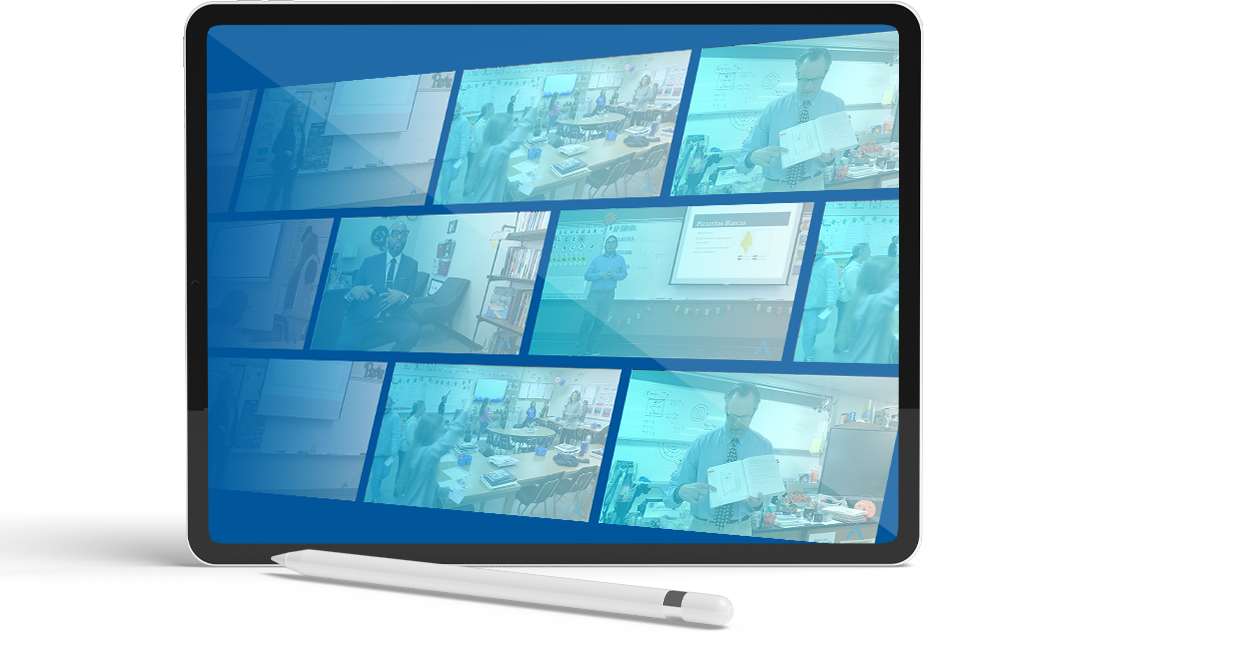Teachers’ most cited reason for getting into teaching is to make an impact on students’ lives. Having a love for learning themselves, they want to pay it forward. Professional development for teachers is consistently proven to make a difference in student outcomes. Use this guide to get an overview of the top researched questions and topics on professional development for teachers and dive deeper into the areas that interest you most.
What is professional development?
Learning doesn’t end when we obtain a degree and enter the working world. It’s an ongoing process of continuous self-improvement, growth, and exploration of the world around us. Professional development for teachers includes any activities that help expand your knowledge, grow your skill set, or advance your career goals.
No matter how long you’ve been a teacher, there will always be opportunities to hone your craft and learn new things. Sometimes best practices from 20 years ago, 10 years ago, or even just two years ago, may require tweaks, slight adjustments, or reinterpretations to meet today’s education climate. The COVID-19 pandemic taught us valuable lessons and forced some systematic changes on the education industry. Teachers went back to relying on what we knew best and practices proven to work, but reimagined them to meet modern challenges. Virtual teaching has become essential to continuity in learning, and professional development for teachers in the new normal is a rising interest for education leaders.
Professional development for teachers may include any activities that help expand your knowledge, grow your skill sets, or advance your overall career goals. It is a great way to become a better teacher, gain deeper understanding of your students, advance your career, and challenge yourself in and out of the classroom.
Why is professional development important?
No matter how long you’ve been teaching, the potential for professional growth and improvement exist. Even the most respected and experienced teachers engage in continuous self-improvement.
Why should teachers continue to learn? Education is a field that is constantly undergoing change. It must continuously evolve in response to the developing needs of students, emerging research about best learning practices, and a rapidly changing world outside the classroom.
In addition to meeting any mandatory guidelines necessary for state licensure renewal, there are many benefits of professional development for teachers. Chief among them is becoming a better, more effective, and well-rounded teacher. Better teachers lead to better student outcomes, increased academic achievement, and stronger student engagement at all ages.
Aside from the benefits for students, many ask, “how is professional development beneficial for teachers?” Teachers who engage in professional development often find it makes their job easier and paves the way for advancement among other benefits.
Professional development is an investment into both yourself and your students. It not only supports your own personal and professional growth as a teacher but also boosts student success.
What are some examples of professional development?
Effective professional development models often cover many diverse topics relevant to teaching and can come in many different forms. Examples of professional development include:
- State-mandated training and continuing-education hours required to maintain your licensure as a teacher
- Local teacher professional development workshops, conferences, or seminars that provide learning opportunities and lead to stronger connections and a better support network
- Self-directed professional development websites for teachers, which are gaining popularity as they allow teachers to learn at their own pace and self-appointed time while giving them some control over their development path
How can teachers plan their own professional development?
Step One: Reflection
Determining good professional development goals for teachers starts with an honest inventory. Consider your skills, classroom experiences, and any other identifiable growth opportunities as an educator, and record your assessment.
Some questions to ask yourself include:
- Do you feel you’re living up to your full potential as an educator? Why or why not?
- Are there consistent challenges you experience in the classroom?
- Is there a technology, teaching tactic, or pedagogical approach you’ve heard of but haven’t had a chance to try?
Your students aren’t likely to succeed academically without sufficient studying and preparation ahead of important tests or assignments. The same is true for teachers as you approach professional development targeting specific areas of need. By taking steps ahead of time to identify potential problem areas and ways to address or improve your abilities in that area, you’re already in the right mindset and well on your way to effective self-improvement.
Step Two: Set S.m.a.r.t. Teacher Goals
S.M.A.R.T. is a helpful acronym for specific, measurable, attainable, results-based, and time-bound. Smart goals for teachers’ professional development should follow this model.
- Specific: Each goal should state what will be done, how, and who will do each task involved. Without the structure of specificity, the goal will be more difficult to achieve in a timely manner.
- Measurable: Each goal should have a way by which you’ll measure your progress. Measuring helps keep you on track. Even if you don’t reach your goals, measuring progress shows how far you’ve come and can motivate you to keep going.
- Attainable: Be sure your goals are challenging, but realistic. If you don’t have the resources to achieve the goal, you are setting yourself up for failure.
- Results-based: Consider creating student-centered goals that have meaning for you but will also ultimately impact the relevant learning by your students.
- Time-bound: Establish a specific timeline for each goal so that you have a definite start and end date. This keeps you progressing on schedule.
Questions to Ask
Planning your own professional development

Are you living up to your full potential as an educator?

Are there consistent challenges you experience in the classroom?

Is there a tool you’ve heard of but haven’t had a chance to try?
Step Three: Create Your Professional Development Plan
Once you have a set of goals in mind, it’s time to put it all together. Begin by pairing your professional development goals with projected dates in your timeline for achieving them. Establish progress checkpoints for incremental improvements over several months. List out the strategies, resources, and professional development resources for teachers you’ve selected to achieve your goals. Share your professional development plan with a supervisor, mentor, or fellow teacher to solicit feedback and finalize your plan. Sharing your plan can also add a layer of accountability and support for your efforts.
S.M.A.R.T. Teacher Goals
Specific
Measurable
Attainable
Results-Based
Time-Bound
Teacher-Led Professional Development
As experts in the education field, many schools have turned to teachers to spearhead staff-led professional development initiatives. Learning best practices and exchanging ideas among peers are always helpful endeavors, although a thoughtfully planned approach is more likely to produce impactful and transformative professional development results.
Survey your fellow teachers ahead of time for insight into the topic areas most relevant and beneficial for the entire group, and create active learning opportunities that include strategies teachers can take back to their classrooms and apply to their lessons. Providing teachers with a voice and choice in their learning opportunities creates a sense of ownership and ultimately a more productive professional development experience.
Meet regularly throughout the year, conducting periodic check-ins to review progress, exchange new ideas, or follow up on and build upon new skills and strategies learned. Sustaining your professional development and receiving ongoing support from peers of all backgrounds and tenures gives you a greater chance to successfully implement new practices that positively impact students’ learning.
Essential professional development topics for teachers
When considering professional development topics for your own self-study or learning community group discussion, keep in mind the following collection of subject areas that can affect children of all ages and learning levels.
Strengthening Student Engagement – Student engagement is one of the most important predictors and gauges of a child’s success both in and outside the classroom. Studies and research show engaged students receive higher grades, are more motivated to learn, and are 4.5 times more likely to feel hopeful about the future than their disengaged peers.
Building Relationships – Your students have full lives outside of the classroom. Get to know them as individuals rather than just students. Positive teacher-student relationships impact academic performance and can even result in long-term health benefits for both teachers and students.
Establishing Rules and Procedures – According to Vanderbilt University’s IRIS Center, “Teaching rules and procedures to students at the beginning of the year, and enforcing them consistently across time, increases student academic achievement and task engagement.”
Setting Effective Learning Goals – Student goal setting can produce positive outcomes for students, helping them identify and track their progress over the semester or subject unit.
Developing Quality Assessments – Traditional tests and quizzes will always have their place as formal assessment tools, but developing your informal assessment abilities is paramount for helping determine how well students are grasping new concepts and information mid-lesson.
Optimizing Direct Instruction – How students are taught can be just as important as what they’re taught when it comes to how well they absorb, retain, and can apply new information. Project Follow Through, a landmark study sponsored by the federal government involving more than 200,000 children and 22 different teaching models, found direct instruction practices produced the best student results in areas of basic academic skills, problem-solving skills, and self-esteem.
Practicing and Deepening Student Learning – After students are presented new content, teachers need to make a conscious effort to deepen learning in both declarative and procedural knowledge. To commit new learning to long-term recallable memory, teachers should guide students through practices and strategies designed for this purpose.
Professional Development Topics
Building Relationships
Rules & Procedures
Effective Learning Goals
Quality Assessments
Direct Instruction
Student Learning
Which professional development opportunities will be best for new teachers?
There’s no more pivotal—and often challenging—time in a teacher’s career than their first few years on the job.
From teacher and principal burnout, staff shortages, and insufficient pay to student behavioral issues and lack of teaching time, many factors add difficulties for new teachers as they begin this new phase in their lives and careers.
Research from the National Association of Secondary School Principals and the Learning Policy Institute says nearly half of new teachers decide to leave the profession within their first five years, with almost 10 percent leaving after just their first year.
New teachers typically have room to grow in many areas. Seeking assistance and taking advantage of professional development resources, especially early in their career, is a practical and proven way to address challenges they may not have expected before beginning their career.
Seasoned and veteran teachers commonly recommend three target areas of professional development for new teachers. First on their list is proactive and effective time management. Time is one resource almost every educator wishes they could have more of, but there are small and simple strategies new teachers can take to manage their schedule and growing responsibilities.
Second, experienced teachers suggest new teachers focus on classroom management. Even among teachers with student teaching experience or prior roles working with children, managing a full classroom of students can, at times, be overwhelming for new teachers. Establishing rules and procedures, sharpening your verbal and nonverbal communication skills, classroom organization, and honing corrective disciplinary practices can help new teachers take charge and manage a classroom with confidence from the beginning.
Finally, veteran teachers stress the importance of building trust within the classroom by learning how to build relationships with and among students. Students lacking positive relationships with their teachers or peers can feel isolated and disengage. Emphasizing and building positive relationships with students also helps with classroom management.
Professional development for teachers online
The COVID-19 pandemic not only forced teachers out of the classroom and into virtual teaching, but it also resulted in professional development efforts proliferating online. More widely accepted by school districts across the nation, replacing or supplementing traditional professional development with online professional development platforms has helped educators participate in professional development in the new normal.
With on-demand courses, videos, and resources, teachers can complete professional learning whenever and wherever works best for them. However, selecting the “best” online professional development for teachers is a personal choice. There are a multitude of options, so make a list of your top considerations and compare three to five different professional development platforms. For example, some factors you may want to consider include:
- How much time do you have to invest? If you are short on time, look for a platform that allows you to consume the material in a relatively short amount of time. Watching hour-long videos may not work for you.
- Do you need it to count towards your continuing education requirements? Professional development doesn’t have to count towards your CE to provide value, but if it’s a priority for you, check into the possibility.
- Are the strategies easy to implement, will they require a lot of preparation, and are there supporting materials available?
Professional Development Online
Do you have time?
Will it count toward your continuing education requirements?
Is it easy to implement?

What is the best professional development for teachers?
Each classroom and teacher’s needs are unique, and there is no one professional development program that fits all. The best professional development for teachers fits within their schedule and includes topics that are relevant to them with strategies that they will want to try in their classroom.
Why should you consider Avanti for your professional growth?
Avanti allows teachers autonomy to complete their professional development and learn anytime, anywhere, and at their own pace—all while targeting the topics relevant to their classroom challenges.
Avanti’s network of education experts are real teachers who have field-tested, refined, and perfected the strategies they share. They have the first-hand experience and knowledge necessary to effectively mentor fellow teachers. Highlights of Avanti include:
- Easy-to-use online platform with easy-to-implement strategies
- Hundreds of strategy-based videos organized by student grade level and content areas
- Accompanying implementation guides, reflection rubrics, and other downloadable resources
- Community sharing and social support features
- Monthly livestream speaker sessions with collaborative discussion
- Teacher training time applies toward continuing education credits for state licensing requirements (Note: confirm with your local district office)


